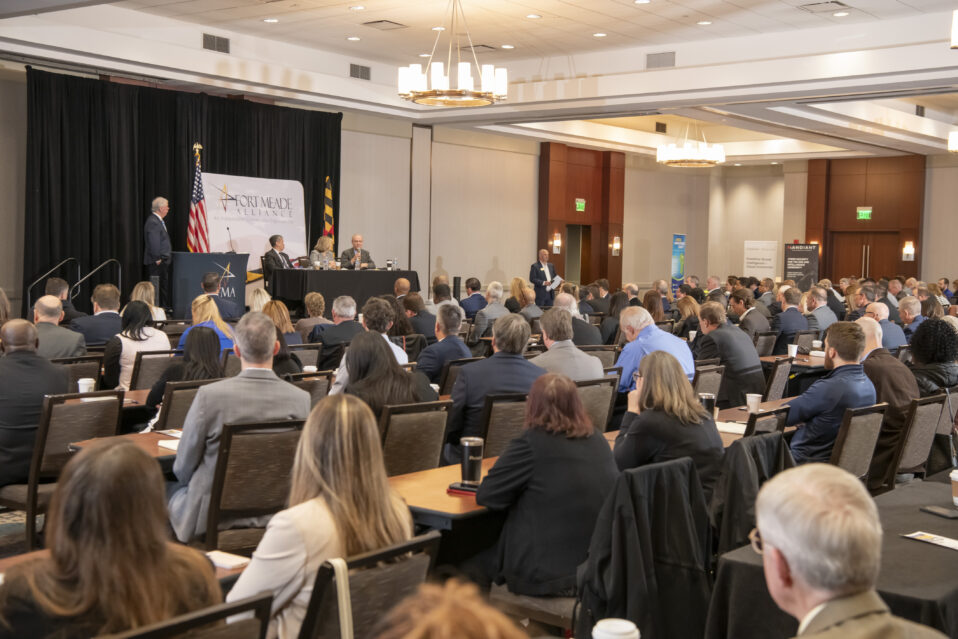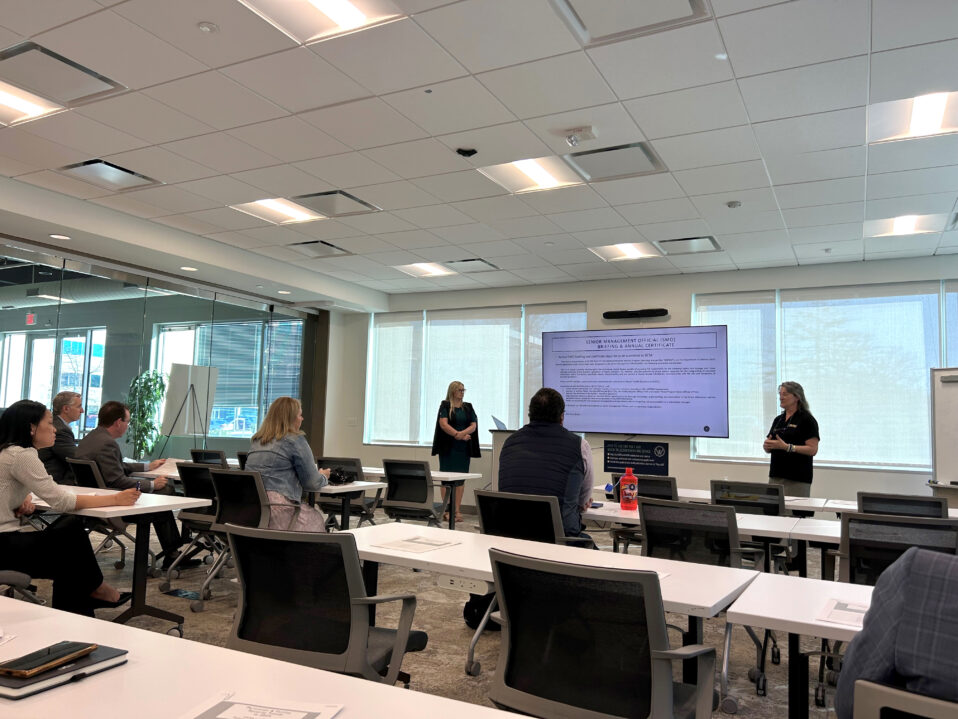From conflicting economic indicators, political uncertainties, labor force challenges, innovation strengths and the quest to establish a new normal after the pandemic, the Fort Meade Region will have to tackle major issues in 2023.
Members of the Fort Meade Alliance weighed in with what they believe will be some of the biggest issues, challenges and opportunities facing the installation, local employers and residents this year.

Four major issues to be faced in 2023 include growing the cyber workforce, reshaping education, evaluating economic strengths and risks, as well as supporting the Fort Meade Community.
“According to Chris Inglis, National Cyber Director, there are 700,000 cyber-related jobs to be filled on any day,” said Doreen Harwood, Chair of FMA’s Education and Workforce Development Committee.
In addition to the labor shortage, the widespread adoption of hybrid work arrangements during the pandemic made it increasingly difficult for classified work environments to attract talent.
“In response to this and other factors, NSA is launching an unprecedented hiring effort in 2023, undertaking one of its largest hiring surges in 30 years with openings for over 3,000 new employees,” Harwood said.
“Everyone I speak to at large businesses and small ones are working diligently to attract and retain the personnel they need to meet mission requirements,” said Bill Dunahoo, Principal and Co-founder of Nexxis Solutions. “We have a very strong workforce in place but need to grow it as missions evolve, technologies change and requirements expand. Despite well publicized layoffs by big tech companies, the flow of talent into the Fort Meade community is not meeting all the needs. We all have to work together to expand the talent base in order to meet the challenge at hand.”
To contend with those challenges, many professionals insist that national security and cybersecurity operations adopt new approaches to workforce development.

“A major challenge for workforce development for both the government and Defense Industrial Base (DIB) is being able to hire cyber-skilled personnel who do not have four-year degrees but instead have certifications and hands-on experience,” Harwood said. “Hiring requirements for government positions as well the labor category descriptions within government contracts generally require a B.S. or B.A. degree… Making a four-year degree optional would enable access to a qualified workforce to help address this significant hiring gap.”
Cyber apprenticeships would further ease the labor shortage, she added. The cost of paying an apprentice’s salary and education costs over several years is a hard sell to employers even if the apprentice is required to remain with that employer for several years. Consequently, “direct engagement with DIB companies along with the success of a few pilot programs is needed in order to establish apprenticeships as a viable option to fill the 700,000 available jobs in cyber.”
Furthermore, employers need to start preparing now for an imminent drop in the number of college-educated cyber professionals, said Frank Goertner, Director of Federal and Veteran Affairs that the University of Maryland Robert H. Smith School of Business.
“Starting in 2007, the domestic birth rate dropped significantly and has never recovered. National projections suggest up to a 15.9 percent drop in college-age, native-born Americans starting in 2025,” Goertner said.
That “demographic cliff” will acutely impact industries, such as national defense and cybersecurity, that depend on college educated, U.S. citizens “but I don’t hear a lot of people talking about that yet,” Goertner said.
The cyber industry, he added, will need to increase efforts to “cultivate interest in their industry much earlier – pre-college” and support efforts to provide college education to a greater diversity of students.
As President of Anne Arundel Community College (AACC), Dr. Dawn Lindsay admits “the biggest thing that keeps me up at night is trying to predict what the future looks like for educational programs.”
At the beginning of the pandemic, AACC rapidly converted 1,250 classes to online learning, then gradually shifted to range of teaching modalities, including in-person, hybrid and even late-night tutoring services. At the same time, the college juggled work arrangements to support hybrid work and flex hours in order to attract and retain the best employees.
“Our faculty and staff have to be amazing for our college to continue being the number one community college in the nation,” Lindsay said.

AACC is still striving to create the optimal, new normal conditions for employees and students, Lindsay said. But several initiatives are fueling her excitement about what the college could achieve in 2023. AACC’s commitment to diversity has grown the population of non-white students to 40 percent and made the college an increasingly welcome and safe space for minority, LGBTQ and differently abled students, she said. The Blueprint for Maryland will soon enable high school students to earn up to 15 community college credits free of charge, easing a major, financial barrier to college education. And the opening of the Education and Resiliency Center at Kuhn Hall is enabling AACC to offer numerous classes on post.
Lisa Swoboda, Senior Director of Military and Federal Affairs at the Maryland Department of Commerce, suggested another opportunity to support education and workforce development in the Fort Meade Region.
“The FY23 NDAA hit record funding levels in cyber infrastructure, workforce and AI. Finding ways to leverage this funding for the benefit of the cyber missions on and around Fort Meade are critical,” Swoboda said. “The Fort Meade Alliance should promote the newly established DOD Cyber and Digital Service Academy scholarship-for-service program as an opportunity for students to enroll and serve our country with a promising career path. Promoting nationally what the region has to offer to students across the country…will lead to filling numerous vacancies and bring new energy and workforce talent.”
Amid conflicting economic projections, one clear economic concern lingered over the Fort Meade Region at the beginning of 2023, namely the possibility of a debt ceiling crisis.
“The debt ceiling is the biggest concern for federal contractors,” said Jay Baldwin, Fort Meade Alliance Foundation Treasurer.
Local employers must also prepare for the possibility of a recession in 2023, Baldwin said.
In addition, the impacts of any recession are expected to be relatively mild in Maryland.
“Regardless of no real consensus on whether or not 2023 will experience a recession, the Fort Meade region will still see healthy economic activity,” said Larry Twele, CEO of the Howard County Economic Development Authority. “In the industrial sector, it is busier than ever. Industrial vacancies are down below 3 percent due to storage of safety stock to guard against supply chain disruptions, last mile distribution centers and facilities supporting increased activity at the Fort.”

Even the office market is fairing well in Howard County, Twele added. Office vacancy dropped a full percentage point from January 2022 to January 2023 due largely to employers adopting a ‘spoke model’ that places smaller but high quality and highly amenitized offices in more locations close to talent.
The region is continuing to see strong acquisition and consolidation of companies, said Paul Gentile of Panther LLC. “I have mixed reactions to this… On the negative side, the reduction in the number of small companies could serve to fuel staff to leave the area. On the plus side, the result could be more opportunities for staff post acquisition simply as a result of being part of a larger organization… Finally on the plus side, there is so much very cool and exciting work to be done in this region. This should serve as a magnet for staff to both remain and relocate to this region.”
The Fort Meade Region has additional reasons to expect positive economic developments in the near future, Goertner said.
“Federal funding from the CHIPS Act, infrastructure law and expanded NDAA is hitting government agencies alongside more flexible hiring and acquisition authorities. Combined, they are prompting the most dynamic government-wide engagement for new federal talent and business I’ve ever seen,” he said. “Meanwhile, Maryland is quickly establishing itself as a unique innovation hub for technologies demanding highly integrated public-private investment. Bio-tech, cyber-tech, fin-tech: each is joining defense tech as something Maryland is uniquely positioned to accelerate like nowhere else on the planet.”
As Maryland emerges from the pandemic, some members of the Fort Meade Region are focusing on increasing their support for individual community members.
“For the pandemic years, Fort Meade, like so many other communities, adapted how we operated to focus on the most essential functions while limiting risks of COVID-19 exposure and a possible complete shutdown. Meanwhile, the organizational and population growth within our base did not stop and continues on today,” said COL Michael Sapp, Garrison Commander. “This is the year to rediscover how we best care for and support our residents, stakeholders and tenant organizations, and to reestablish those processes and opportunities that they need. This can only be done by building upon the existing connections of the community. To this end, what keeps me up is the fear that we could fail to meet someone’s needs (from individual to organization) not due to prioritization or availability of resources but due to missed opportunities stemming from lack of communication or the complexity of the environment. This includes matters of employment, education, transportation or any matter of resilience.”
The FMA has new opportunities and heightened needs to support the children of the region, Swoboda said.

“Childcare remains a high priority for DoD. Military installations nationally are experiencing a workforce shortage in childcare workers. The generous federal benefits package and DoD childcare provider incentives are not enough to attract as many workers needing to fill the vacancies. This is a readiness issue for DoD,” she said. “This is an area where in 2023 the Fort Meade Alliance can leverage the state and federal governments’ childcare incentives to create an awareness campaign as to the value a career in early childhood education… Expanding the immediate pool of childcare providers in the Fort Meade region alleviates military family concern over long CDC waitlists and provides incoming families with the support they need.”
FMA, she added, should also work to certify local schools under the Purple Star Schools program. “A school designated as a Purple Star assures incoming military families of schools that have been vetted as military-connected and stand ready to support their child in school transition and keep them on track for college and career success. The program is so important to DoD that they have made it a factor in their basing decision process.”



